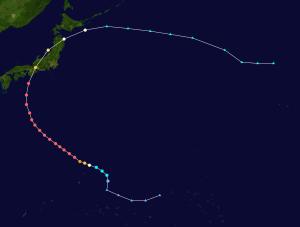
On Sept. 26, 1959, a powerful Super Typhoon struck Japan and became the deadliest and most intense tropical cyclone to make landfall in that nation’s history. The storm was given the name Vera from the Joint Typhoon Warning Center’s list, but in Japan it became infamous for the damage it did to Ise Bay (Isewan in Japanese) and is known there as the “Isewan Typhoon.”
The system was first detected on Sept. 20th and within a day had been upgraded to tropical storm strength by JTWC based on reconnaissance. It remained under surveillance by the USAF WRS 54 “Typhoon Chasers” until landfall five days later. They documented a rapid intensification of Vera from its formation until Sept. 23rd when the maximum sustained winds were observed to be 175 kts (324 kn/hr) and its central pressure fell to 896 mb. Although it weakened somewhat from this peak, by the time it made landfall on the main Japanese island of Honshu three days later, the maximum sustained winds were still at 160 kts (260 km/hr). The typhoon rapidly weakened as it moved quickly over Honshu to the Sea of Japan, then recurved back over the island. It continued out over the North Pacific as an extratropical low.

The worst of the storm surge of 13 feet (4 meters) in Ise Bay was caused by the orientation of the winds, the narrow entrance of the Bay, and its shallowness. Poorly constructed earthen dikes gave way, and storm-driven waves smashed housing along the shore. In addition, heavy rains preceded Vera and continued through its trek over Japan, resulting in heavy flooding and landslides inland. The damage and death toll have remained uncertain. The damage estimates range from US$260 to $600 million. Deaths totals range from 4500 to 5100 people, Although the storm was constantly tracked and well forecast, the Japanese media’s coverage lacked a sense of urgency and many people were ill-prepared for the typhoon’s arrival.
Despite prompt relief efforts by the Japanese government and U.S. Armed Forces, there was an outbreak of dysentery as well as water shortages and food rationing. The city of Nagoya remained flooded by salt water for weeks after the storm. This spurred the government to revamp its disaster preparedness and response system including passing the Disaster Countermeasures Basic Act, which established the Central Disaster Prevention Council. There were also improvements made to Japan’s coastal flooding defenses.